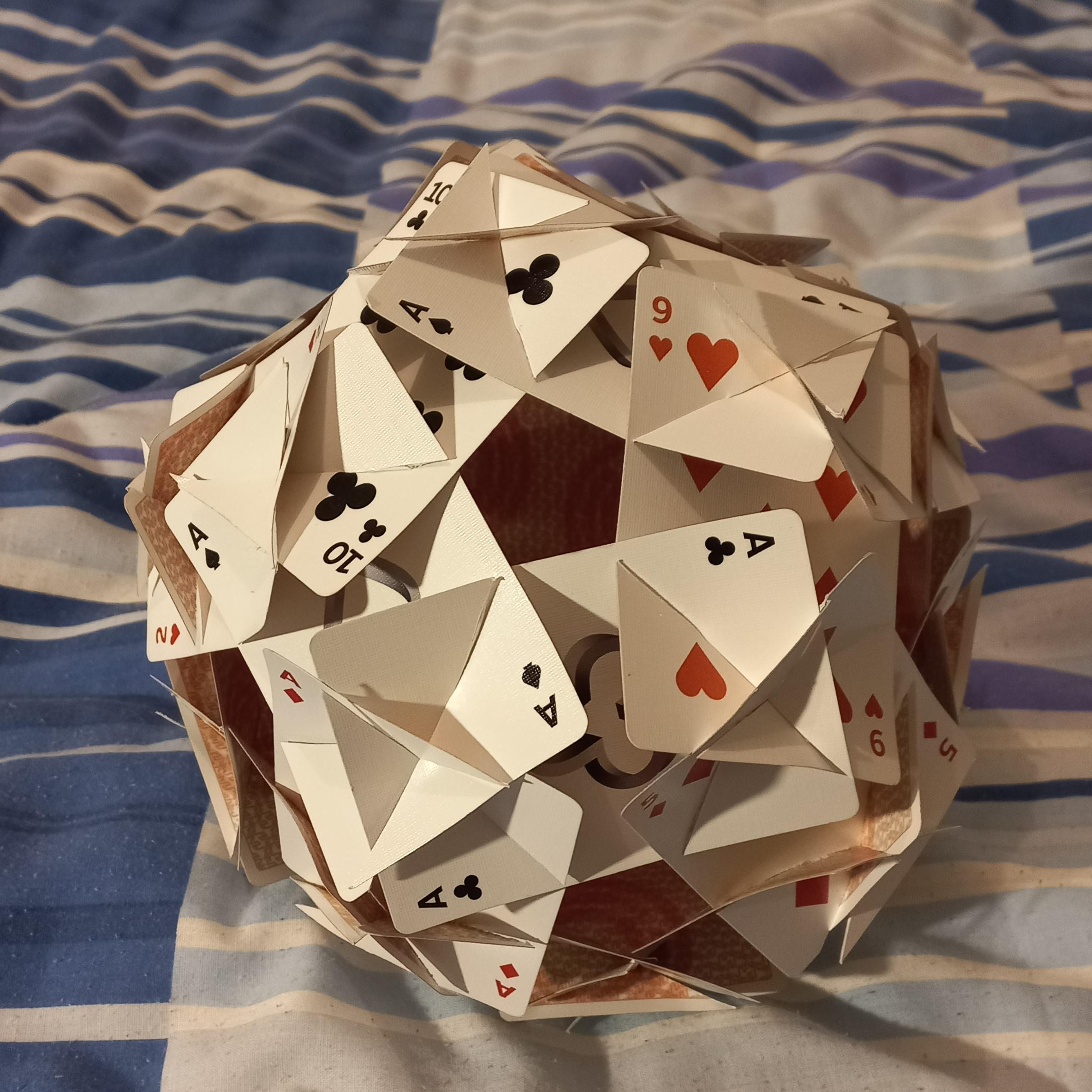Card Polyhedra
Playing cards seem to be the default merch for math-student-seeking companies. This always seemed a little strange to me given that they are the stereotypical incarnation of probability, and numerous maths students seem (unfortunately) opposed to any form of statistics. Despite this, these cheap pieces of card (which might explain their prevalence) have accumulated in my bedroom, having been given to me from FinTech companies every open day and employment fair.
With no use for 7 decks, I thought that I could use a few to make something vaguely interesting and mathematical. Luckily, I was not the first to think of this. George W. Hart (mathematical sculptor and father of Vi Hart) has two templates on his website for a deltoidal hexecontahedron and a rhombic triacontahedron.


Cutting the cards was a bit repetitive, but the construction process was enjoyable. The deltoidal hexecontahedron (made with 60 cards) has vertices where 3 cards (which act as faces) meet and vertices where 5 meet. The latter are quite fragile but easy to construct. The 3-card vertices are quite difficult to interlock, but much more rigid. They involve a decent amount of bending, which is slightly visible in the final product. I can't tell you how I wove them together, but after enough struggling they seem to just fit (if you are following Hart's guide, note that my polyhedra have opposite chirality). I have included a picture of the fit if that is of any help. The rhombic triacontahedron (made with 30 cards) consists only of 3-card vertices, so is more sturdy once built and can be rolled around.

If you want to attempt to make these, I'd suggest converting a spare card into template and using a Stanley knife. The cuts need to be made within 2-3mm for the cards to fit together snugly. The deltoidal hexecontahedron took maybe an hour and a half to cut and 45 minutes to construct, and the rhombic triacontahedron took about half that time. Hart's suggestion of using 2 decks and making both works well (especially given I made a few mistakes cutting). The constructions themselves are quite stunning, though a little faulty when you inspect them closely (though this is my own fault). The cards are a little bent from twisting them in place, though I'm sure more practice would fix this.
After constructing them, I was interested by the geometry of each of them. The way the 5-card vertices meet in the deltoidal hexecontahedron makes it clear how it can be derived by breaking up the faces of a dodecahedron into kites and pushing them outwards. Additionally, the holes along the vertices makes it easier to see the dual Rhombicosidodecahedron.
Given that the orientation of the cards is perpendicular to the orientation of the rhombic faces, the underlying polyhedra is harder to see in the rhombic triacontahedron (I do prefer this choice of card orientation though, as it leads to striking overlaps at the 3-card vertices). The 12 large holes at the 5-card vertices at first suggested the dual to be a dodecahedron, however, closer inspection shows the faces are all rotated by (and its dual is clearly not an icosahedron), indicating it's an icosidodecahedron instead.
Given that all cards were cut identically, it is clear that both are Catalan solids. Also, as Hart notes, the bilateral symmetry is used in the vertices, so similar constructions (all based upon a singular template) must also have bilaterally symmetric faces. I'm interested in making a rhombic hexecontahedron at some point, as it is both face-transitive and bilateral, though the concave faces are a potential issue. If I ever get around to it, I'll post the templates and a few images.